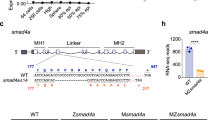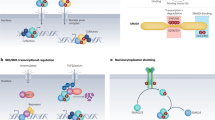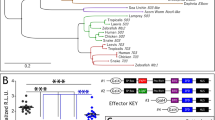Abstract
The transforming growth factor-β (TGF-β) superfamily encompasses a large group of structurally related polypeptides that are capable of regulating cell growth and differentiation in a wide range of embryonic and adult tissues1. Growth/differentiation factor-1 (Gdf-1, encoded by Gdf1 ) is a TGF-β family member of unknown function that was originally isolated from an early mouse embryo cDNA library2 and is expressed specifically in the nervous system in late-stage embryos and adult mice3. Here we show that at early stages of mouse development, Gdf1 is expressed initially throughout the embryo proper and then most prominently in the primitive node, ventral neural tube, and intermediate and lateral plate mesoderm. To examine its biological function, we generated a mouse line carrying a targeted mutation in Gdf1. Gdf1−/− mice exhibited a spectrum of defects related to left-right axis formation, including visceral situs inversus, right pulmonary isomerism and a range of cardiac anomalies. In most Gdf1−/− embryos, the expression of Ebaf (formerly lefty-1) in the left side of the floor plate and Leftb (formerly lefty-2),nodal and Pitx2 in the left lateral plate mesoderm was absent, suggesting that Gdf1 acts upstream of these genes either directly or indirectly to activate their expression. Our findings suggest that Gdf1 acts early in the pathway of gene activation that leads to the establishment of left-right asymmetry.
This is a preview of subscription content, access via your institution
Access options
Subscribe to this journal
Receive 12 print issues and online access
$209.00 per year
only $17.42 per issue
Buy this article
- Purchase on Springer Link
- Instant access to full article PDF
Prices may be subject to local taxes which are calculated during checkout




Similar content being viewed by others
References
McPherron, A.C. & Lee, S.-J. The transforming growth factor β superfamily. in Growth Factors and Cytokines in Health and Disease (ed. LeRoith, D.) 357–393 (JAI, Greenwich, 1996).
Lee, S.-J. Identification of a novel member of the transforming growth factor-β superfamily. Mol. Endocrinol. 4, 1034– 1040 (1990).
Lee, S.-J. Expression of growth/differentiation factor 1 in the nervous system: conservation of a bicistronic structure. Proc. Natl Acad. Sci. USA 88, 4250–4254 (1991).
Meno, C. et al. Two closely-related left-right asymmetrically expressed genes, lefty-1 and lefty-2: their distinct expression domains, chromosomal linkage and direct neuralizing activity in Xenopus embryos. Genes Cells 2, 513–524 ( 1997).
Meno, C. et al. Left-right asymmetric expression of the TGFβ-family member lefty in mouse embryos. Nature 381, 151– 155 (1996).
Collignon, J., Varlet, I. & Robertson, E.J. Relationship between asymmetric nodal expression and the direction of embryonic turning. Nature 381, 155–158 (1996).
Lowe, L.A. et al. Conserved left-right asymmetry of nodal expression and alterations in murine situs inversus. Nature 381, 158–161 (1996).
Yoshioka, H. et al. Pitx2, a bicoid-type homeobox gene is involved in a lefty-signaling pathway in determination of left-right asymmetry. Cell 94, 299–305 (1998).
Piedra, M.E., Icardo, J.M., Albajar, M., Rodriguez-Rey, J.C. & Ros, M.A. Pitx2 participates in the late phase of the pathway controlling left-right asymmetry. Cell 94, 319–324 (1998).
Ramsdell, A.F. & Yost, H.J. Molecular mechanisms of vertebrate left-right development. Trends Genet. 14, 459–465 (1998).
Hummel, K.P. & Chapman, D.B. Visceral inversion and associated anomalies in the mouse. J. Hered. 50, 9– 13 (1959).
Layton, W.M. Random determination of a developmental process: reversal of normal visceral asymmetry in the mouse. J. Hered. 67, 336 –338 (1976).
Ivemark, B.I. Implications of agenesis of the spleen on the pathogenesis of conco-truncus anomalies in childhood. Acta Paediatr. Scand. 44, 1–110 (1955).
Kosaki, K. & Casey, B. Genetics of human left-right axis malformations. Semin. Cell Dev. Biol. 9, 89–99 (1998).
Nonaka, S. et al. Randomization of left-right asymmetry due to loss of nodal cilia generating leftward flow of extraembryonic fluid in mice lacking KIF3B motor protein. Cell 95, 829– 837 (1998).
Okada, Y. et al. Abnormal nodal flow precedes situs inversus in iv and inv mice. Mol. Cell 4, 459– 468 (1999).
Zhou, X., Sasaki, H., Lowe, L., Hogan, B.L.M. & Kuehn, M.R. Nodal is a novel TGFβ-like gene expressed in the mouse node during gastrulation. Nature 361, 543–547 (1993).
Wilkinson, D.G. In Situ Hybridization: A Practical Approach 163 (Oxford University Press, New York, 1992).
Knecht, A.K., Good, P.J., Dawid, I.B. & Harland, R.M. Dorsal-ventral patterning and differentiation of noggin-induced neural tissue in the absence of mesoderm. Development 121, 1927– 1935 (1995).
McPherron, A.C., Lawler, A.M. & Lee, S.-J. Regulation of skeletal muscle mass in mice by a new TGF-β superfamily member. Nature 387, 83– 90 (1997).
Laird, P.W. et al. Simplified mammalian DNA isolation procedure. Nucleic Acids Res. 19, 4293 (1991).
Oh, S.P. & Li, E. The signalling pathway mediated by the type IIB activin receptor controls axial patterning and lateral asymmetry in the mouse. Genes Dev. 11, 1812– 1826 (1997).
Acknowledgements
We thank P. Dunlap for assistance in maintaining mice and P. Wilcox for histotechnology support. C.T.R. was supported by a training grant from the NIH. This work was supported by a grants R01HD30740 and R01HD35887 from the NIH (to S.-J.L.).
Author information
Authors and Affiliations
Corresponding author
Rights and permissions
About this article
Cite this article
Rankin, C., Bunton, T., Lawler, A. et al. Regulation of left-right patterning in mice by growth/differentiation factor-1. Nat Genet 24, 262–265 (2000). https://doi.org/10.1038/73472
Received:
Accepted:
Issue Date:
DOI: https://doi.org/10.1038/73472
This article is cited by
-
Bicc1 and Dicer regulate left-right patterning through post-transcriptional control of the Nodal inhibitor Dand5
Nature Communications (2021)
-
Genetics of Transposition of Great Arteries: Between Laterality Abnormality and Outflow Tract Defect
Journal of Cardiovascular Translational Research (2021)
-
Phylogenetic evidence for independent origins of GDF1 and GDF3 genes in anurans and mammals
Scientific Reports (2018)
-
Contribution of rare inherited and de novo variants in 2,871 congenital heart disease probands
Nature Genetics (2017)
-
Epigenetic silencing of GDF1 disrupts SMAD signaling to reinforce gastric cancer development
Oncogene (2016)



